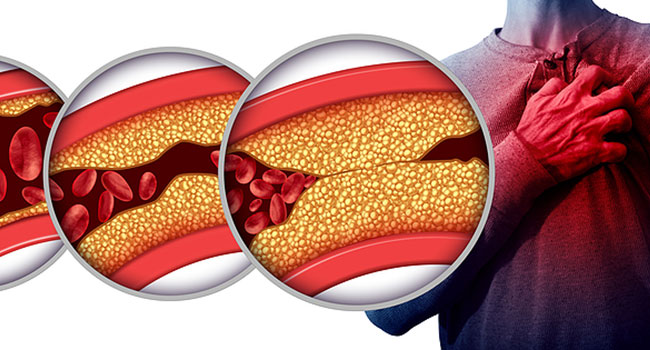
Coronary artery disease is a preventable disease of the heart wherein the arteries supplying oxygen-rich blood to the heart are unable to carry out their functions leading to impaired heart pumping and functioning.
Coronary artery disease occurs when the vessels supplying oxygen-rich blood to the heart are partially or completely blocked as a result of the building up of fats in these blood vessels.
Risk Factors of Coronary Artery Disease
Factors predisposing you to increased risk of coronary artery disease include- high levels of blood cholesterol, high blood pressure, high blood sugar levels, and your cigarette smoking habits, sedentary lifestyle, obesity, and having family members with a history of similar heart disease.
Signs and Symptoms
As a result of impaired blood supply to your heart, you may experience central chest pain (Angina) as tightness or squeeze like sensation around the chest which may radiate to your arms or shoulders. You may experience shortness of breath or even be overly aware of your heartbeat. Sweating and fatigue may also be present. The more the blockage of your arteries, the more severe these symptoms are.
In stable angina, symptoms appear during exertion and are relieved when taking medication or following rest. Whereas chest pain progressively worsens without physical exertion and is not relieved on taking rest or after taking medications are termed unstable angina. Pain in unstable angina lasts longer and the risk of a heart attack when a complete blockage of coronary arteries occurs is high in such cases. It is a medical emergency.
Diagnosis
Diagnosis of the disease is made based on your medical history, physical examinations, and various investigative modalities which include:
- Blood tests to assess levels of cholesterol and blood sugar. Assessing levels of cardiac enzymes in your blood can help to diagnose if you have had or are having a heart attack. The 3 major enzymes that are elevated during a heart attack include-Troponin, Creatinine kinase, and myoglobin. When your heart muscle gets damaged due to inadequate blood supply, these enzymes (proteins) are released by the heart into your bloodstream; as a result, the levels of these enzymes get elevated.
- Electrocardiograph (ECG)-To check for abnormal rhythms in your heart. ECG changes in heart attacks show characteristic changes, whereas patients with episodic angina may be required to undergo stress tests like the Treadmill test to elicit ECG changes. Treadmill test assesses how your heart handles stress/work, as during such states the oxygen demand in the heart is increased; compromised circulation in angina is unable to provide the necessary blood supply to the heart during states of stress.
- Imaging studies of your heart, including MRI and CT scans, also help in diagnosing the condition. Coronary angiography can be done to diagnose conditions of chest pain caused as a result of impaired blood supply. It involves introducing a long thin tube called a catheter into the blood vessels in your arms or groin through which it is guided using X-ray up to the coronary arteries of heart; through which contrast medium is injected and X-ray film is taken to detect blockage or narrowing of these vessels.
Management
Treatment of acute episodes of CAD focuses on relieving symptoms and preventing possible complications. Modalities of treatment currently in use for the treatment of CAD include:
- Anticoagulants: Anti-platelet like Aspirin and clopidogrel disaggregate platelet deposits, which may cause vessels to occlude, it also reduces the ability of the blood to clot and impair blood flow to the heart thus improving symptoms and preventing heart attacks.
- Statins: These are a group of drugs that reduce the level of your blood cholesterol by reducing its synthesis and increasing its uptake from the blood by increasing the number of lipid receptors in the liver. In addition to lowering harmful cholesterol, this group of drugs helps promote healthy functioning of blood vessels and prevent clot formation which obstructs these blood vessels thereby preventing and treating coronary heart disease.
- Beta-blockers: These are a group of drugs that help decrease oxygen demand in the heart and increase coronary blood flow through various mechanisms ensuring demand and supply of oxygen in the heart thus helping prevent and treat anginal chest pain in cases of coronary heart disease.
- Calcium channel blockers and nitrates: These drugs help in widening the narrowed coronary blood vessels thus allowing more oxygen-rich blood to reach the heart, thus relieving symptoms associated with the decreased flow. Nitrates given from the undersurface of the tongue are currently the drug of choice in managing cases of acute angina in an Emergency setting.
- Revascularization: In cases with significant blockage of coronary arteries, revascularization procedures such as Percutaneous Coronary Intervention (PCI) can be done. It is a non-surgical technique in which the narrowed portion of the artery is identified via Angiography and the area is widened with the help of a balloon catheter to ensure adequate blood flow to the heart.
- Coronary Artery Bypass Graft Surgery (CABG): It is a surgical procedure to treat coronary artery disease and involves taking blood vessels from other parts of your body and attaching them to the narrowed coronary artery (Grafting) thus improving blood flow. This is indicated in severe cases.
Treatment Modalities Currently Undergoing Clinical Trials
Research on new drugs and techniques to combat coronary artery disease are in constant study. Let us take a look at some promising treatment modalities currently undergoing clinical trials.
